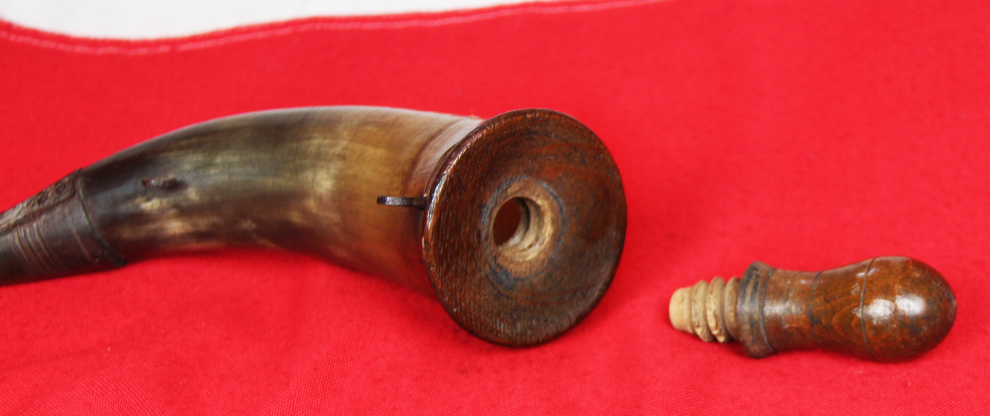18th Century Royal Naval 100 Gunner Ship-Of-The-Line, Gunner's Cannon Priming Flask, Made and Used from the American Revolution, the Battle of Trafalgar and Beyond. Bearing a Royal Naval Ordnance Crown Stamp
King George IIIrd period. Used in the Royal Navy from the 1770's onwards. This is from a wonderful very small collection of fine, early, British Royal Naval pieces that we acquired. A traditional and most rare King George IIIrd period, 18th century gunner's flask, used on board a warship for likely 50 years or more, into the early 19th century of the Admiral Nelson period, and through the Napoleonic Wars.
A Royal Naval gunner's priming powder flask, of polished cow horn body, with traditional turned wooden base with screw threaded removable handle, with Royal Naval Ordnance Crown Stamp {see photo 10}, turned brass and spring actioned pouring spout, and two iron carrying rings.
A near identical example is in Oxford University's Pitt Rivers Museum that came from a gunner serving on HMS Victory at Trafalgar see photo in the gallery In the firing naval cannon at Trafalgar, huge amounts of gunpowder were required to fire them, and the cannon were ignited with very fine quality, fine ground priming powder poured into the touch hole. Young boys, often known as powder monkeys, would haul gunpowder to the gun decks within barrels. Cow horns flasks, with brass spring actioned spouts, just such as this one, were used to contain the fine grain priming powder, which was poured into the pan of the touch hole of each cannon before firing. The example that can be seen photographed in our gallery was donated to the Pitt Rivers Museum in Oxford by the Wellcome Historical Medical Museum (now Wellcome Institute) in 1952, it is said to have belonged to a gunner on Admiral Nelson's flagship, HMS Victory.
The Victory famously led a fleet of twenty-seven British ships to victory over Napoleon's forces at the Battle of Trafalgar in October 1805, although Nelson himself sustained a mortal injury aboard deck. Because the vast majority of an 18th century ship's armament was mounted in its broadside, fleets typically formed into a single line ahead in preparation for battle. This simplified command and control each ship could simply follow the ship in front and enabled the fleet to uniformly arrange its firepower along a continuous formation with no weak spots. The line was sometimes divided into van (forward), centre, and rear divisions under subordinate commanders. Maintenance of a continuous, unbroken line was important. If the enemy was able to position directly ahead or behind a friendly ship, he would be comparatively safe from attack (as only a handful of guns fired directly ahead or astern) and could concentrate his broadside against the weakest parts of his target the lightly constructed bow and stern. For this reason, fleet battles often resolved into two parallel lines of ships edging towards each other with each ship indecisively facing its opposite. More aggressive admirals sought ways to overcome this tactical stalemate, concentrating their force against a smaller portion of the enemy by breaking the line.
Firing began once the fleets closed within range. At the extreme, cannon shot might reach the enemy at ranges up to a mile, but British commanders often held their fire until the ships had closed to only a few hundred yards, or even less. The adversaries would then pour fire into one another, shattering hulls, masts, rigging, and men with heavy cannon shot. Individual ships might surrender by hauling down (striking) their colours when disabled by damage or casualties. As a last resort, a ship might be forced to surrender through boarding. Battle usually continued until one side disengaged or the sun set though a number of battles were fought partly or entirely in the dark.
Priming powder was a refined type of gunpowder that ignited more easily and so it was important to use the right amount. Too much powder could be catastrophic, too little powder might prevent ignition of the main charge in the breech, resulting in just a flash in the pan. Here, a brass mounted spring catch helped control the amount that was poured out. Two screw hooks can be seen where the horn would have been attached to a belt or baldrick and slung around the gunner?s torso, and it could be refilled by unscrewing the wooden stopper at the broad end.
Horn was an ideal material for powder flasks as it was readily available and provided a natural container; unlike metal it was not liable to create sparks that might accidentally ignite the powder inside; and it was also translucent when held up to the light, so it was possible to see how much powder was left.
See photos 8 and 9 in the gallery that shows the identical gunner's priiming flask on board HMS Victory, as part of the museum's display
This flask is just under 11 inches long.
Code: 22928
1625.00 GBP










